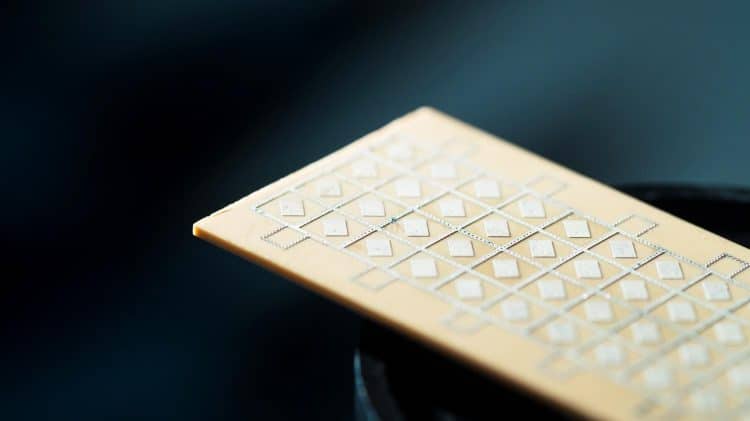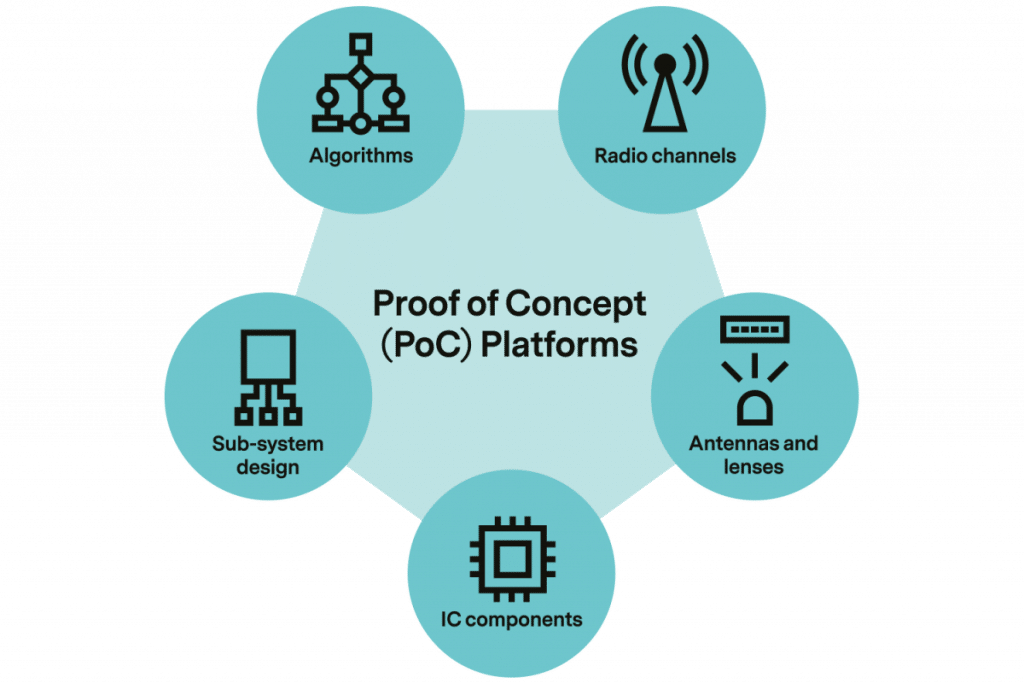
Measurement and Proof of Concept Capabilities Up to 330 GHz
6G Flagship’s radio frequency (RF) experts create proof of concept (PoC) platforms where the research outputs of the group members are integrated, seamlessly. The group focuses on two main PoC categories – technology or component demonstrations, and platform demonstrators – which integrate multiple standard and PoC components.
Previously, the RF group has created a complete 5G mmWave radio unit for wireless backhauling purposes. Now, a new mmWave radio platform is under development. “For 6G purposes, we are currently developing measurement and PoC capabilities up to 330 GHz,” says Dr. Marko Leinonen who leads experimental radio research in the RF laboratory.
A successful PoC platform requires effective teamwork between multiple researchers and organisations due to the complex interactions between used technologies. “The complete radio platform requires integration of radio frequency components, antennas, printed circuit boards and controlling software into one system, which have similar functionalities as radios used in base or mobile stations,” Leinonen says. “We have successfully demonstrated multiple 5G antennas as individual antenna elements and integrated into the complete arrays. We have also developed complete 5G mmWave radio platforms with electrical beam steering, and with the same platform, we have evaluated several interference mitigation methods. The RF IC design team has developed and measured several world leading designs which can be implemented into the larger radio platforms, as well.”
With its unique skillset, the group combines innovative component design, system analysis and measurements leading to verified solutions. “An efficient and parallel usage of multiple electronic computer-aided design tools is an essential success factor for any high performing radio frequency circuit and antenna design,” Leinonen says. “We have state-of-the-art measurement equipment in our radio laboratory which are crucial for the evaluations and measurements of the designed radio components.”
A closer look at five experts’ intertwined expertise areas illustrates some of the major research and development challenges that the experts are now solving.
Integrated Circuit (IC) design
The mmWave and THz RF receiver integrated circuits that Sumit Pratap Singh designs and develops will be implemented and integrated into the 6G radios.” A major goal of the RF group is to design a complete 6G transceiver, and the designed low noise amplifiers and downconverters are some of the main building blocks at the receiver side,” Singh says. “By implementing these blocks and then combing them with components such as antenna and phase shifters, a phased array receiver will be designed to meet the criterion of ultra-high-speed transceiver for future 6G radio system.”
As his most promising achievement, Singh names “breaking the barrier by achieving the good power gain beyond half of maximum frequency of oscillation (Fmax) over wide bandwidth with decent noise performance.” The results have been published in the benchmarking paper on low-noise amplifier (LNA) design at sub-terahertz , presented in the 2021 IEEE Radio Frequency Integrated Circuits Symposium (RFIC). This takes the RF group significantly closer to the target of implementing/completing a THz transceiver for 6G communication using exiting process technologies with limited speed at THz frequency range.
Antenna design
Antennas are essential components to demonstrate anything over-the-air since no radio link can work without antennas. In the modern communication systems, antennas are not only converters of conducted signals to radiated ones, but they also operate as frequency- and spatial-domain filters, impedance matching elements, mechanical supports, and may conduct heat away from the transceiver IC.
In comparison with previous mobile generations, the higher frequency in 6G sets increased demands on antennas. “Antenna gain must compensate for limited transceiver performance and reduced antenna reception area,” says Dr. Markus Berg, who conducts 6G antenna research in the RF group.
High gain results in a narrow radiation beam, which in turn causes need for dynamic beam steering in the case of a mobile user. However, high gain antennas have typically fixed radiation beams achieved by electrically large dielectric lens structures. “Developing a high gain beam steering antenna for 6G is a challenging task,” Berg says. “A possible solution is to develop hybrid antennas combining lenses with phased arrays to enable beam steering and high gain.”
Sub-system development
The next level of RF design after individual components is integrate them to functioning sub-systems. Mikko Hietanen researches and develops the millimeter wave RFIC-frontend. His work is limited by the performance of the used semiconductor process and the requirement of simplicity of the design. “Designing amplifiers at technology limits forces the designer to work with as simple circuits as possible to maximize performance,” Hietanen says. “Hence, the technology dictates the level of sophistication.”
The sub-system development as such follows the same principles as any system development. “We design standalone blocks, combine them together, and fine-tune the sub-system for optimum performance,” Hietanen says.
In absence of 6G system and corresponding radio signal, the group uses 5G new radio signals for the design validation purposes. “Showcasing performance with real-world signals proves the end result without leaving open questions about modeling accuracy or mistakes in simulations,” Hietanen confirms. “As a result, prototypes are benchmarked as close as possible to product level in terms of functionality in early phases of development.”
Channel models
The measurement capability for above 100 GHz frequencies is now developing and measurement data is accumulating from different sources, including our own. “We are getting more insights into interactions of radio waves and various materials, and their frequency dependency,” says Dr. Pekka Kyösti, who focuses on radio propagation measurements, estimation, and channel modelling in the RF group. “The accumulated measurements begin to provide a limited statistical view on transmission loss and multi-path characteristics in considered environments and frequencies.”
Radio channel and propagation studies are enablers for other fields of research and development. Hence the progression of propagation research advances real-life 6G adoption indirectly. “Radio channel measurements at above 100 GHz frequencies are typically very slow to conduct due to high gain requirement of measurement antennas,” Kyösti says. “The measurement-based knowledge is still in its infancy and most combinations of frequency, environment and deployment still need to be measured.”
In a recent journal article “How many beams does sub-THz channel support” , the team introduced three methods to approximate the number of beams building on data from real indoor measurements performed at 140 GHz. The initial 6G channel models will be extensions of measured propagation data. “The use of such stored channel models is highly realistic and provides a good basis for evaluations on PoC platforms,” Kyösti says.
Radio algorithms
Early on, the RF team took the decision to develop a radio PoC platforms instead of using commercial options. “When I started working around my topic many years ago, there were no commercial mmWave phased array platforms available,” says Nuutti Tervo who creates spatial linearization concepts of phased array transmitters. “If I would have waited for those to be mature enough, my research would have been very limited. As we are jointly developing the PoC, we get to decide together what we should include in the design to support and solve our specific research problems. And with the novel approaches, we can have scientific impact in early phase.”

For his own research, Tervo needed a real phased array transmitter. RF and especially power amplifiers have a very fundamental problem – a nonlinear nature of behavior, and this problem is clearly visible with power amplifiers at the region where their power efficiency is the highest. “In my own research, I look for ways how an antenna array can beamform its nonidealities,” Tervo says. “In phased antenna arrays, we have learned that the linearization can be designed in the array level. Basically, it means that the individual elements can compensate for each other over-the-air for linearization purpose.”
PoC development thus has importance on multiple levels of research and development. “We really are depending on each other to get the research done,” Tervo says. “With real-life experiments, we can learn how our technical solution has impact on the big picture. This is very motivating, and at the same time, it is very educative. You learn to think outside of the box which may lead to solutions that others are omitting. And we have good results in the end.”
This article has been published in the 6G Waves magazine. Get a taste of our digitalized future and download the latest issue of 6G Waves for free!